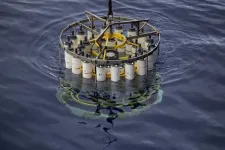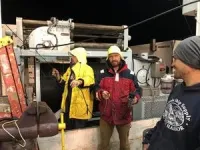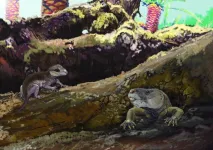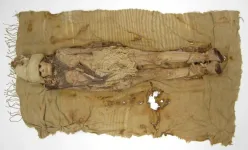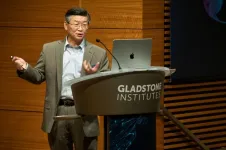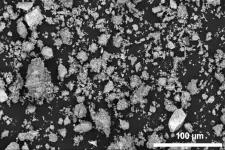New study: Deep-sea discovery shines light on life in the twilight zone
Unexpected findings expand our understanding of the impacts of climate change, including how and where the ocean stores carbon, said co-author and University of South Florida scholar Tim Conway
2024-09-25
(Press-News.org) TAMPA, Fla. (Sept. 23, 2024) – The ocean’s twilight zone is deep, dark, and — according to new research — iron deficient.
No sunlight reaches this region 200 to 1,000 meters below the sea surface, where levels of iron, a key micronutrient, are so low that the growth of bacteria is restricted. To compensate, these bacteria produce molecules called siderophores, which help the bacteria scavenge trace amounts of iron from the surrounding seawater.
The paper detailing these unexpected findings from the Pacific Ocean will publish on Wednesday, Sept. 25, at 11 a.m. ET (4 p.m. London Time) in Nature, and will be viewable at that time at this link. The study could change the way scientists view microbial processes in the deep ocean and offer new insight into the ocean’s capacity to absorb carbon.
“Understanding the organisms that facilitate carbon uptake in the ocean is important for understanding the impacts of climate change,” said Tim Conway, associate professor of chemical oceanography at the USF College of Marine Science, who co-authored the recent study. “When organic matter from the surface ocean descends to the deep ocean, it acts as a biological pump that removes carbon from the atmosphere and stores it in seawater and sediments. Measuring the rates and processes that influence this pump gives us insight into how and where the ocean stores carbon.”
To conduct the study, researchers collected water samples from the upper 1,000 meters of the water column during an expedition through the eastern Pacific Ocean from Alaska to Tahiti. What they found in the samples surprised them. Not only were concentrations of siderophores high in surface waters where iron is expected to be deficient, but they were also elevated in waters between 200 and 400 meters deep, where nutrient and iron concentrations were thought to have little impact on the growth of bacteria.
“Unlike in surface waters, we did not expect to find siderophores in the ocean’s twilight zone,” said Conway. “Our study shows that iron-deficiency is high for bacteria living in this region throughout much of the east Pacific Ocean, and that the bacteria use siderophores to increase their uptake of iron. This has a knock-on effect on the biological carbon pump, because these bacteria are responsible for the breakdown of organic matter as it sinks through the twilight zone.”
The recent discovery was part of GEOTRACES, an international effort to provide high-quality data for the study of climate-driven changes in ocean biogeochemistry.
The study of siderophores is still in the early stages. Researchers involved in GEOTRACES only recently developed reliable methods to measure these molecules in water samples, and they’re still working to understand where and when microbes use siderophores to acquire iron.
Although the research into siderophores is new, this study demonstrates their clear impact on the movement of nutrients in the ocean’s twilight zone.
“For a full picture of how nutrients shape marine biogeochemical cycles, future studies will need to take these findings into account,” said Daniel Repeta, senior scientist at Woods Hole Oceanographic Institution and co-author of the article. “In other words, experiments near the surface must expand to include the twilight zone.”
Funding for this work was provided by the National Science Foundation and the Simons Foundation. The U.S. portion of GEOTRACES is provided by the National Science Foundation.
Click here for images and a PDF of the journal article
###
About the University of South Florida
The University of South Florida, a high-impact research university dedicated to student success and committed to community engagement, generates an annual economic impact of more than $6 billion. With campuses in Tampa, St. Petersburg and Sarasota-Manatee, USF serves approximately 50,000 students who represent nearly 150 different countries. U.S. News & World Report has ranked USF as one of the nation’s top 50 public universities for five consecutive years, and this year USF earned its highest ranking ever among all universities public or private. In 2023, USF became the first public university in Florida in nearly 40 years to be invited to join the Association of American Universities, a prestigious group of the leading universities in the United States and Canada. Through hundreds of millions of dollars in research activity each year and as one of the top universities in the world for securing new patents, USF is a leader in solving global problems and improving lives. USF is a member of the American Athletic Conference. Learn more at www.usf.edu.
END
ELSE PRESS RELEASES FROM THIS DATE:
2024-09-25
These fossils, belonging to the mammal-precursor species Brasilodon quadrangularis and Riograndia guaibensis, offer critical insights into the development of the mammalian jaw and middle ear, revealing evolutionary experiments that occurred millions of years earlier than previously thought.
Mammals stand out among vertebrates for their distinct jaw structure and the presence of three middle ear bones. This transition from earlier vertebrates, which had a single middle ear bone, has long fascinated scientists. The new study explores how mammal ancestors, known as cynodonts, evolved these features ...
2024-09-25
People with Down’s syndrome face a higher risk of developing Leukemia. Now researchers from the University of Copenhagen and Stanford University explain why, by identifying specific changes in blood cells of people with Down’s syndrome.
In the world, one out of 700 children are born with Down’s syndrome. A syndrome, where the child has an extra copy of chromosome 21, resulting in 47 chromosomes instead of 46. This typically results in characteristic physical features and some level of learning disability.
But newborns with Downs syndrome also tend to have an elevated number of red blood ...
2024-09-25
About The Study: Treatment-emergent nirmatrelvir resistance mutations were commonly detected, especially in individuals who were immunosuppressed in this cohort study of 156 participants. However, these mutations were generally present at low frequencies and were transient in nature, suggesting a low risk for the spread of nirmatrelvir resistance in the community with the current variants and drug usage patterns.
Corresponding Author: To contact the corresponding author, Jonathan Z. Li, MD, MMsc, email jli@bwh.harvard.edu.
To access the embargoed study: Visit ...
2024-09-25
About The Study: In this study, semaglutide was associated with reduced opioid overdose risk in patients with comorbid type 2 diabetes and opioid use disorder, suggesting its potential therapeutic value for preventing overdoses. The results need validation from other data resources and study populations. Further research is warranted to investigate the underlying mechanisms and randomized clinical trials are necessary to corroborate the clinical effects on opioid use disorder.
Corresponding Authors: To contact the corresponding authors, email Rong Xu, PhD, (rxx@case.edu) ...
2024-09-25
Food fermentation is the oldest production practice using microorganisms in human history. Milk fermentation, for example, can be traced back to 6000–4000 BC in India, and Mediterranean populations produced and consumed cheese as early as 7000 before present (BP).
Despite the long history of human consumption of fermented products, though, little has been known about the history of the use of fermentative microorganisms and the history of related cultural transmission. In particular, the evolutionary trajectories, especially functional adaptation, of these ...
2024-09-25
Adults with opioid use disorder who receive a higher daily dose of the opioid addiction treatment medication buprenorphine may have a lower risk of subsequent emergency department visits or use of inpatient services related to behavioral health (such as for mental health and substance use disorders) than adults receiving the recommended dose, according to an analysis funded by the National Institutes of Health (NIH). These findings suggest that higher buprenorphine doses could be more effective in managing opioid use disorder, which may be particularly relevant for improving treatment for those who use fentanyl, a major ...
2024-09-25
With the climate pattern known as El Niño in full force from mid-2023 to mid-2024, global temperatures broke records for 12 months in a row. As one of the strongest El Niño events on record, it was likely the main culprit of unprecedented heat, floods and droughts worldwide.
In a new study published Sep. 25 in the journal Nature, a University of Colorado Boulder climate scientist and collaborators reveal that the planet could see more frequent extreme El Niño events by 2050 if greenhouse gas emissions continue to increase.
“It’s ...
2024-09-25
Imagine being one cartwheel away from changing your appearance. One flip, and your brunette locks are platinum blond. That’s not too far from what happens in some prokaryotes, or single-cell organisms, such as bacteria, that undergo something called inversions.
A study led by scientists at Stanford Medicine has shown that inversions, which cause a physical flip of a segment of DNA and change an organism’s genetic identity, can occur within a single gene, challenging a central dogma of biology — that one gene can code ...
2024-09-25
Gladstone Institutes has established a new scientific award, the Sobrato Prize in Neuroscience, to advance breakthroughs in brain research with high potential for patient impact—and announced it will present the inaugural prize to Yadong Huang, MD, PhD, a trailblazer in Alzheimer’s research.
In his nearly three decades at Gladstone, Huang has led a series of pioneering studies on the genetic underpinnings of Alzheimer’s disease, with discoveries that have opened multiple new avenues for drug development. He ...
2024-09-25
Rechargeable lithium-ion batteries are growing in adoption, used in devices like smartphones and laptops, electric vehicles, and energy storage systems. But supplies of nickel and cobalt commonly used in the cathodes of these batteries are limited. New research led by the Department of Energy’s Lawrence Berkeley National Laboratory (Berkeley Lab) opens up a potential low-cost, safe alternative in manganese, the fifth most abundant metal in the Earth’s crust.
Researchers showed that manganese can be effectively used in emerging cathode materials called disordered rock salts, or DRX. Previous research suggested that to perform well, DRX materials had to be ground down to nanosized ...
LAST 30 PRESS RELEASES:
[Press-News.org] New study: Deep-sea discovery shines light on life in the twilight zone
Unexpected findings expand our understanding of the impacts of climate change, including how and where the ocean stores carbon, said co-author and University of South Florida scholar Tim Conway
